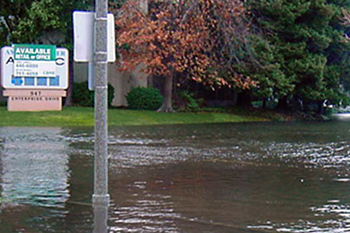Before and during a flood...
Know your flood risk:
The two types of flooding that can most likely occur within Sacramento County are localized and riverine. Be aware of and understand and be prepared for the flood risk in your neighborhood!
 Localized Flooding
Localized Flooding
Localized flooding occurs in both urban and nonurban areas during or after a storm. Any storm, particularly slow-moving, steady rain storms, can overwhelm drainage systems. When the system backs up, pooling water can flood streets, yards and even the lower floors of homes and businesses.
Localized flooding can often be prevented or minimized by keeping your storm drain free of debris. Rake Your Leaves and disposed of them in your green waste can or use them as mulch for your garden.
 Riverine Flooding
Riverine Flooding
Riverine flooding occurs when rivers, streams and lakes overflow their banks. This includes flooding caused by levee failure and channel erosion. Areas adjacent to local streams and creeks can also experience flooding as a result of excessive runoff from heavy rainfall and accumulation of water flowing over broad flat areas. Of particular concern in California are the deep floodplains of the Central Valley, which are subject to periodic riverine flooding. Riverine flooding can be widespread, with floodwaters persisting for several hours to days, weeks or more.
Know your weather alerts:
Tune into select radio and television stations to obtain storm preparedness tips! The Stormwater Utility will air radio public service announcements during the winter season alerting residents of winter storms and how to be prepared.
Radio:
Television:
Sign up for Emergency Alerts:
Sacramento Alert will give residents notice if there is an emergency in the county. The system provides information to residents about emergency events quickly and through a variety of communication methods.
Here's more information on how to sign up for Sacramento Alert.
Real Time Flood Monitoring System:
The Automated Local Evaluation in Real Time (ALERT) system collects rainfall and stream-level data, and provides Web site updates every 15 minutes through a network of 48 gauging stations. The ALERT site enables you to monitor the level of nearby creeks and rivers during heavy and/or continuous rainfall events.
Know your flood warnings:
Floods can take several hours to days to develop while flash floods can take only a few minutes to a few hours to develop.
Flood Watch: A flood is possible in your area.
- Move your furniture and valuables to higher floors of your home.
- Fill your car's gas tank, in case an evacuation notice is issued.
Flood Warning: A flood is already occurring or will occur soon in your area
- Listen to local radio and TV stations for information and advice. If told to evacuate, do so as soon as possible.
Flash Flood Watch: A flash flood is possible in your area.
- Be alert to signs of flash flooding and be ready to evacuate on a moment's notice.
Flash Flood Warning: A flash flood is occurring or will occur very soon.
- If you think a flash flood has started already, evacuate immediately. You may have only seconds to escape. Act quickly!
- Move to higher ground away from rivers, streams, creeks, and storm drains. Do not drive around barricades...they are there for your safety.
- If your car stalls in rapidly rising waters, abandon it immediately and climb to higher ground.
A Flash Flood Statement or Flood Statement: This is follow-up information regarding a flash flood or flood event.
An Urban and Small Stream Advisory: Flooding of small streams, streets and low-lying areas (such as railroad underpasses and urban storms drains) is occurring.
(Definitions are based on those from the National Weather Service.)
